North Vietnam, New Year Stamps, January 16th, 1962, Michel Nr. 192-193; The Chinese New Year was important for Vietnam due to the large number of ethnic Chinese population that was living in Vietnam and the fact that China was a major military and economic supporter of the Government. Curiously enough though 1962 was the year of the tiger but the stamps featured the year of the pig and rooster. Two stamps were issued. One with a 6 xu nominal (intra-city rate) and the other with 12 xu (standard domestic letter rate). These stamps were produced with horizontally and vertically ribbed paper, depending on how the paper was fed into the printing press.
Here is the official Xunhasaba bulletin that was released upon the issuance of these stamps.
Here is a mint set if the horizontally ribbed paper: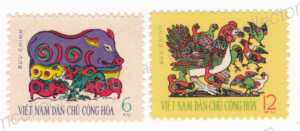
This is a mint set on vertical ribbed paper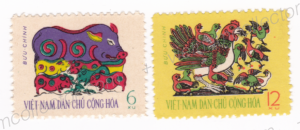
These stamps were not officially released imperforate but a very small number of imperforate trial proofs have come to market. This one is also missing the black color run. It carries a single rust-red print run on the reverse. Note the positional mailings surrounding the stamp image.
Reverse of the trial proof.
Production erros did occur. Here is a 12 xu stamp that shows a printing flaw that was most likely caused by a small object that fell on the printing plate during the printing process. It looks like an “0” that is positioned behind “Viet”.
Very rare single franking of the 6xu value on a local letter sent on the intra-city rate inside Hanoi. These intra-city tariff mailings are nearly impossible to find as most local letters were destroyed during the multi-decadal war, the tropical climate or recycling due to raw material shortages.
This is a very interesting and very rare local letter that was sent from a suburb in Hanoi to an address in the city. It carries a 6xu New Year stamp that covered the intra-city tariff (but not the 12xu domestic letter rate). It appears therefore that the intra-city rate was interpreted to include suburbs. Again, most local letters were destroyed during the multi-decadal war, the tropical climate or recycling due to raw material shortages.
Rare multiple franking of the 6xu value covering the 12xu tariff for a domestic letter. Again, most local letters were destroyed during the multi-decadal war, the tropical climate or recycling due to raw material shortages.
Rare single franking of the 12xu value on a letter sent from Hanoi to the Soviet Union. Moscow airport cachet, Moscow arrival cancel on the reverse.
Another, rare single franking of the 12xu value on a letter (full contents preserved) sent to Czechoslovakia in January of 1962.
Mixed franking with a complete set sent registered to Klewitz on the First Day of Issuance (January 16th, 1962). The letter was franked with 73 xu which was insufficient for a registered letter to West Germany (1.10 Dong). However, the clever sender wrote “CHDC Duc” at the bottom of the address which stood for “East Germany”. The standard letter rate to a fellow socialist country was only 12 xu plus the 60 international registration fee amounted to a required postage of 72 xu. The con was never noticed by the post office.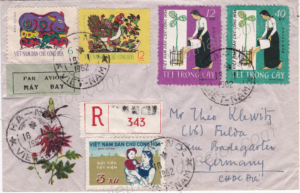
Very rare express mail letter sent to Klewitz in Mach of 1972. It features five stamps of the 6 xu value plus values from the artist set for an overall postage of 1.78 Dong. The strip is on vertically ribbed paper. The single stamp is on horizontally ribbed paper. Express mail letters from North Vietnam are very hard to find. The postage can be explained by the 50 xu standard letter rate to West germany, the international registration fee (60 xu) and the express mail fee (exact amount unknown).
Spectacular multiple franking of the 12 xu New Year stamp in two different color shades. The red and green colors on the left four stamps are lighter than the block of four on the right. The letter was sent registered and by express mail to Klwitz in March of 1972. The overall postage of 1.96 can be explained with the 50 xu standard letter rate, the 60 xu international registration fee and the express mail fee. Note the passer markings on the selvage.
Colorful mixed franking of the 30xu Artist stamp with other NVN stamps (including the 6xu New Year stamp) for an overall postage of 72xu. The letter, sent from Bin Luc (small post office) was addressed to Theo Klewitz in West Germany and so should have cost 50xu postage plus 60xu registration fee for a total of 1.10D. However, the sender only wrote “Germany” on the envelope leaving it open if the letter was going to East or West Germany. The postal clerk hence accepted the lower 12xu postage to East Germany by mistake.
Very rare registered express mail letter sent to Klewitz in October of 1977. The letter carries most of the im-perforated goat beetle set plus an im-perforated stamp of the dragon fly set. There are also two of the 12 xu New Year stamps. Im-perforated stamps on postally used cover are very rare. The overall postage amounted to 4.00 Dong.Fulda arrival cancel on the reverse. Green Fulda customs cachet on front.
Rare registered express mail letter sent from Haiphong to Klewitz in August of 1978. It carries pairs of the grey-blue inscription 6 and 12 xu stamp and pairs of the other 6xu and 12 xu stamps. There are also two of the 30 Dong National Liberation Front (Viet Cong) stamps. The currency of the Viet Cong stamps represented the currency of the South Vietnamese Regime and hence was not compatible with the Dong of North Vietnam. Also Viet Cong stamps were, according to postal regulations, not to be used or cancelled in the North. This regulation clearly was disregarded in this particular case. 6 xu New Year stamp on the front. Disregarding the technically invalid Viet Cong stamps the overall postage amounted to 4.28 Dong. Fulda arrival cancel on the reverse.
Rare registered express mail letter sent to Klewitz in August of 1978. It carries the National Union set thrice plus a 6 xu New Year stamp. The overall postage amounted to 4.20 Dong. Fulda arrival cancel on the reverse. Green Fulda custom cachet on front.
Another rare registered express mail letter mailed to Klewitz in August of 1978. The letter carries the other half of the perforated plus the 6 xu New Year stamp. The overall postage amounted to 4.04 Dong. Fulda arrival cancel on the reverse. Green Fulda custom cachet on front.
Rare registered express mail letter sent to Klewitz in October of 1980. It carries the entire set plus the 6 xu New Year stamp for an overall postage of 4.81 Dong. Fulda arrival cancel on the reverse. Green Fulda custom cachet on front. Unusual hand-made express mail label.
Registration Nr. 100660


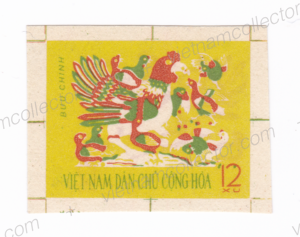
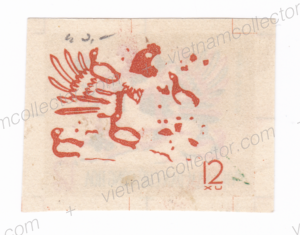
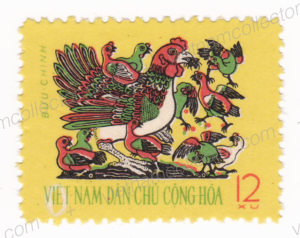
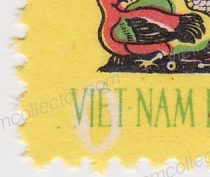
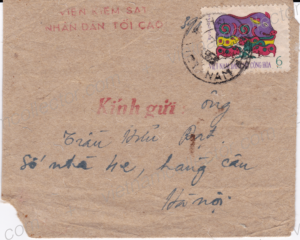
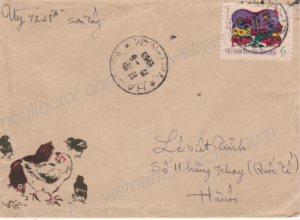
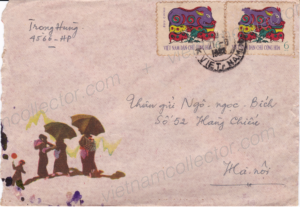
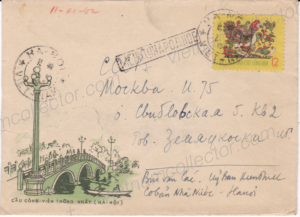
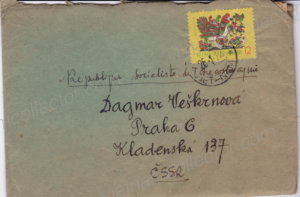
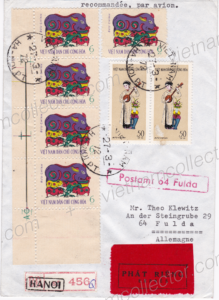
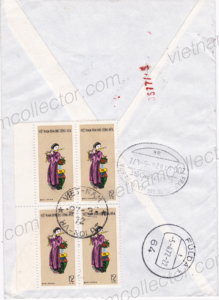
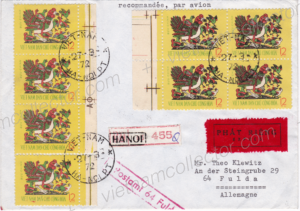
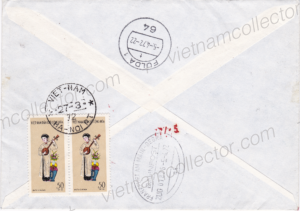
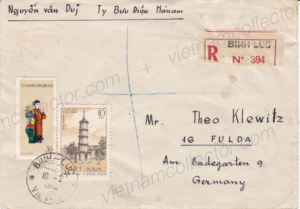
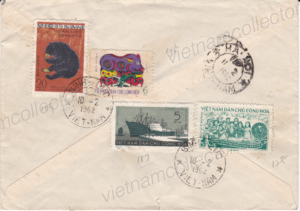
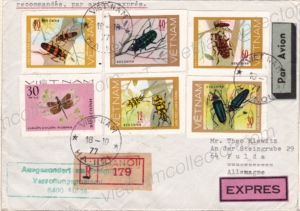
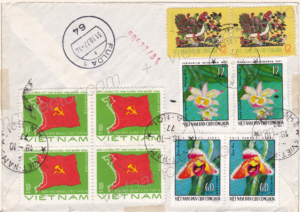
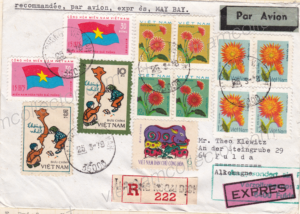
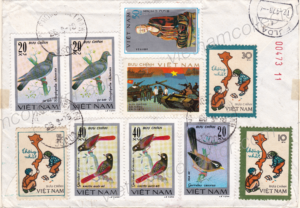
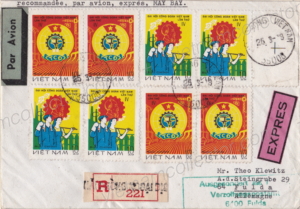
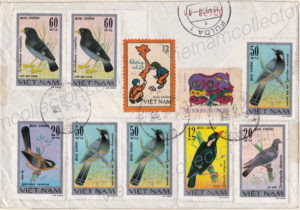
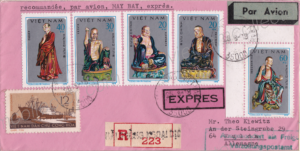

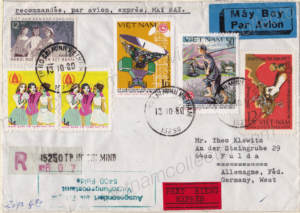
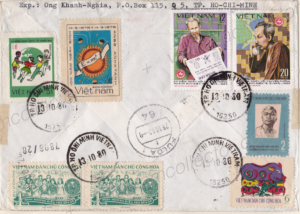

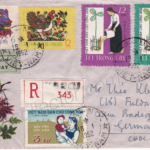


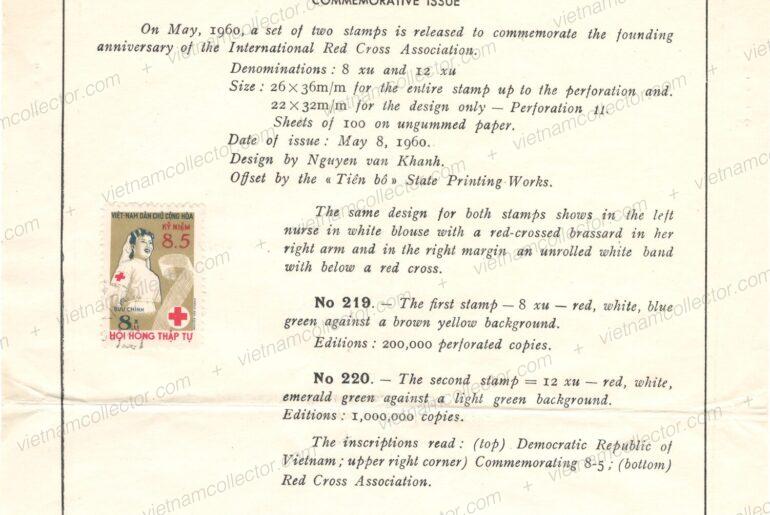
Comments are closed.